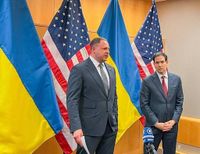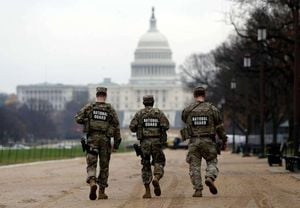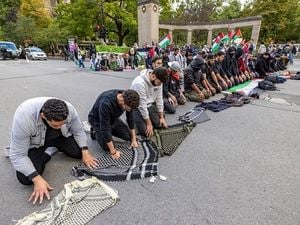As the world watched with bated breath, a flurry of diplomatic activity unfolded this past week, aiming to end the bloodiest conflict Europe has seen since World War II. The United States, under President Donald Trump, launched a bold new peace initiative to halt Russia’s full-scale invasion of Ukraine, but the plan has sparked fierce debate, both on Capitol Hill and across the Atlantic.
The urgency of these negotiations was underscored by grim events on the ground. According to Project Syndicate, Russia unleashed a devastating barrage on Ukrainian cities last week, firing more than 500 drones, cruise missiles, and rockets. While most were intercepted, the attack struck two apartment buildings in Ternopil, western Ukraine, killing at least 31 civilians, including six children. Homes, shops, post offices, and power plants across Ukraine were set ablaze, a stark reminder that the war’s horrors continue even as diplomats search for peace.
Amid these attacks, news broke that President Trump and Russian President Vladimir Putin had been quietly negotiating a settlement. The discussions, initially shrouded in secrecy, centered on a 28-point plan reportedly crafted by Trump’s special envoy, Steve Witkoff—a billionaire real estate mogul—and Kirill Dmitriev, the head of Russia’s sovereign wealth fund. Trump demanded Ukraine accept this backroom deal by November 27, 2025, though he left open the possibility of further changes.
Details of the original plan, as reported by the Atlantic Council, revealed provisions that alarmed many: a cap on Ukraine’s armed forces, a ban on NATO membership, and the surrender of heavily fortified eastern territories to Moscow. Congressional Republicans were quick to voice their dismay. Senator Mitch McConnell declared, “Those who think pressuring the victim and appeasing the aggressor will bring peace are kidding themselves,” drawing a parallel to what he called “a capitulation like Biden’s abandonment of Afghanistan.” Senator Roger Wicker, chairman of the Senate Armed Services Committee, was equally blunt: “This so-called ‘peace plan’ has real problems, and I am highly skeptical it will achieve peace.”
The backlash wasn’t limited to the Senate. Representative Brian Fitzpatrick filed a discharge petition to force a House vote on sanctioning Russia, directly challenging the White House’s approach. “Correction: The United States wants Russia’s answer on an unconditional withdrawal of Ukraine by Thursday. This Russian-drafted propaganda must be rejected and disregarded for the unserious nonsense that it is,” Fitzpatrick wrote, as quoted by the Atlantic Council. Representative Don Bacon went so far as to say, “The President’s appeasement plan to Russia is forcing our hand,” revealing he had considered resigning over the proposal.
Vice President JD Vance acknowledged the scale of the internal opposition, posting on November 24, “The level of passion over this one issue when your own country has serious problems is bonkers.” The intra-party rift signaled a significant challenge for Trump, who has long boasted he could broker a deal to end the war within 24 hours.
Amid the uproar, Trump’s team scrambled to revise the plan. According to AFP, an official familiar with the updated version described it as “significantly better” for Ukraine. One key improvement was raising the proposed cap on Ukraine’s military forces from 600,000 to 800,000. Ukrainian negotiator Rustem Umerov noted there was “common understanding on the core” of the deal between Ukraine and the United States, but stressed that “remaining details should be hammered out in direct talks at the earliest suitable date” between Presidents Zelensky and Trump.
Still, skepticism abounded. French President Emmanuel Macron threw cold water on hopes for a breakthrough, stating, “There is clearly no Russian willingness” for a ceasefire or to discuss the new, more Ukraine-friendly proposal. British Prime Minister Keir Starmer echoed the sentiment, warning, “There’s still a long way to go and a tough road ahead.”
Negotiations were taking place on multiple fronts. Since the weekend of November 22–24, Ukrainian, US, and Russian representatives have met in Geneva and Abu Dhabi. US negotiator Dan Driscoll expressed optimism: “The talks are going well and we remain optimistic.” The White House cited “tremendous progress,” but cautioned that “there are a few delicate but not insurmountable details that must be sorted out.” Meanwhile, a coalition of 30 countries supporting Ukraine convened by video to coordinate their response to the evolving situation.
Despite diplomatic efforts, the war raged on. Powerful explosions rocked Kyiv in the early hours of November 25, as Russian drones and missiles struck the city, killing seven and sending residents fleeing into underground shelters. According to AFP, thick smoke lit by the orange glow of air defense fire rose over the capital, a stark reminder that peace remains elusive.
The proposed settlement’s most controversial elements—especially the ban on Ukraine joining NATO and the requirement to cede territory—have drawn sharp criticism from both Ukrainian officials and Western allies. According to Project Syndicate, the plan’s flaws go deeper: it risks encouraging nuclear proliferation, undermines the principle of inviolable borders, and offers no credible enforcement mechanisms. “The only meaningful deterrent against new Russian aggression is for Ukraine to join NATO—which the proposed settlement expressly forbids,” the article argues.
The process itself has also come under fire. Ukrainians were reportedly excluded from the initial drafting of the plan, which critics say reads as if “dictated by the Russians and translated by the Americans into English.” European allies, too, were caught off guard, fueling concerns about the legitimacy and durability of any agreement reached behind closed doors.
On Capitol Hill, Congress has yet to pass any legislation to assist Ukraine in 2025, a marked departure from previous years. The Sanctioning Russia Act, introduced in April by Senators Lindsey Graham and Richard Blumenthal, has languished without a vote despite broad support. Fitzpatrick’s discharge petition could change that, potentially forcing a vote on both the sanctions bill and the Democrat-led Ukraine Support Act, which includes military aid. Most Democrats are expected to back the move, though some express quiet concern about provisions granting Trump increased authority to levy tariffs.
Polling suggests Trump’s base is not as supportive of the peace plan as the White House might hope. A survey by the Vandenberg Coalition found only 16 percent of Trump voters agree Ukraine should surrender territory, while 76 percent support sanctioning Russia. This reality may embolden congressional efforts to pressure Russia and bolster Ukraine’s defenses, even as the administration pursues a negotiated settlement.
Ukrainian army Sergeant Ivan Zadontsev captured the ambivalence many feel: “We also are getting tired of war. We need a break,” he told AFP, but added that the proposals “do not serve Ukraine’s national interests.”
As the dust settles on another week of war and diplomacy, it’s clear that the road to peace remains fraught with peril and political complexity. The fate of Ukraine—and the future of the international order—hangs in the balance as negotiators race against time to resolve the remaining points of disagreement before further tragedy unfolds.





